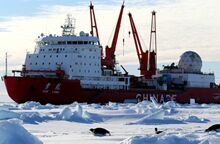研究:南极上空臭氧空洞形状“异乎寻常”
|
科学家们近日表示,今年南极上空臭氧空洞的形状“异乎寻常”,严重向南美倾斜。这表明,常见的极地漩涡发生重大扭曲。 The ozone hole that opens every year over the Antarctic is on course to be the smallest in three decades, scientists have said. 科学家称,南极上空每年出现的臭氧空洞将是30年来最小的。 Researchers say the hole is also a particularly unusual shape this year, being heavily skewed towards South America instead of centring on the South Pole. 研究人员说,今年臭氧空洞的形状也特别不寻常,严重向南美洲倾斜,而不是以南极为中心。
The rare shape – never before observed – indicates a significant distortion to the usual polar vortex, which maintains low temperatures in the stratosphere. 这一罕见的异常形状表明,常见的极地漩涡发生巨大的扭曲。极涡维持着平流层的低温。 vortex [ˈvɔːteks]:n.涡流;漩涡 stratosphere[ˈstrætəsfɪə(r)]:n.同温层 The hole is currently well under half the area that usually opens up by mid-September, and may have already reached its maximum size, a little smaller in area than the Antarctic continent. 目前,臭氧空洞的面积小于通常情况下9月中旬面积的一半,而且可能已经达到最大尺寸,比南极大陆的面积还要小一点。 Ozone is a gas formed in the upper atmosphere when electrical charges in the atmosphere combine with ultraviolet (UV) rays from the sun. The ozone layer absorbs the majority of the sun’s harmful UV radiation. 臭氧是大气中的电荷与来自太阳的紫外线结合时在上层大气中形成的一种气体。臭氧层吸收了太阳大部分有害的紫外线辐射。 The hole disappears and reforms every year over the Antarctic due to the unique weather patterns that create incredibly cold circling winds above the pole. 由于独特的天气模式,南极上空形成了令人难以置信的寒冷回旋风,臭氧空洞每年消失又复现。 According to the British Antarctic Survey, the hole had reached an area of 11 million square kilometres in early September, when the annual “spring warming” event kicked in much earlier than usual. 根据英国南极调查局的数据,9月初春季暖流比往年提早到来,臭氧空洞达到1100万平方公里。 In 2018, the hole reached a maximum area of 22.9 million square kilometres. 2018年,臭氧空洞的最大面积达到2290万平方公里。 In 2002, the polar vortex split in two, creating two separate ozone holes over the continent. 2002年,极地涡旋分裂成两个,在南极大陆上空形成两个独立的臭氧空洞。 Anna Jones a scientist at the British Antarctic Survey told The Independent the shape of the hole this year was “very unusual”. 英国南极调查局的科学家安娜·琼斯告诉《独立报》说,今年臭氧空洞的形状很不寻常。 She said: “Very occasionally in the Antarctic you will get disturbances. And I don’t think anybody knows what’s triggered it this year. This is a pretty new phenomenon. It could be a multiple collection of factors.” 她说:“在南极,很少会受到干扰。我想没有人知道是什么引发了这种改变。这是一种全新的现象,可能是多种因素造成的。” Satellite records for the polar vortex in Antarctica go back to the late 1970s, but the 2002 split vortex is the only other major change. 南极极地涡旋的卫星记录可以追溯到20世纪70年代末,但2002年的分裂涡旋是此前唯一一次重大变化。 “Scientists haven’t quite figured it out yet … there are various things they can look at, but it’s certainly very unusual,” Dr Jones said. 琼斯博士说:“科学家们还没有完全弄清楚,他们要考虑的有各种因素,但这确实很不寻常。” Explaining how the polar vortex normally works, she said: "Over Antarctica you have a very strong westerly wind system which sets up over the winter. You get very cold temperatures over the Antarctic continent and the winds are very fast, which holds it in place." 在解释极地涡旋通常是如何运转时,她说:“在南极洲上空有一个非常强的西风系统,在冬季形成。南极大陆非常寒冷,风速也非常快,让极地涡旋无法移动。” "The winds are driven by the temperature difference between equatorial temperatures and polar temperatures. This is what you expect over the Antarctic." “风是由赤道和极地之间的温差驱动的。这是你在南极洲看到的景象。” equatorial [ˌekwəˈtɔːriəl]:adj.赤道的,近赤道的 "In Antarctica you have a continent surrounded by a flat ocean. You don’t have a lot of stuff at ground level, so the air can flow around without anything getting in its way." “南极洲大陆被平坦的海洋所包围。在地平面上没什么东西,因此空气可以在不受任何阻碍的情况下流动。” "In the Arctic, it’s the opposite. You have an ocean surrounded by landmasses with mountains. So you don’t get the strength of the vortex you get in the Antarctic. " “而在北极,情况恰恰相反。北冰洋被矗立着高山的陆地所包围,因此不会有在南极的那种极地涡旋的强度。” Dr Jones said the key to reducing the size of the ozone hole in the long term was continuing to clampdown on the illegal man-made chemicals causing the destruction. She also warned people living in South America could now be at risk from dangerous UV radiation as the ozone has thinned. 琼斯博士说,长期来看,减小臭氧空洞的关键仍是打击破坏臭氧层的非法人造化学品。她还警告说,随着臭氧层变薄,居住在南美的人们现在可能面临危险的紫外线辐射。 "The key thing is that the gases that destroy ozone are still around, still in the atmosphere," she said. 她说:“关键是,破坏臭氧层的气体仍然存在于大气中。” But a warming planet due to climate change is also bad news for the ozone layer. Higher atmospheric temperatures could also degrade the conditions required to restore the ozone layer. 但是,气候变化导致的全球变暖对臭氧层也不利。更高的大气温度也会降低恢复臭氧层所需的条件。 “If we warm the lower levels of the atmosphere, we actually cool the stratosphere,” Dr Jones said. “This could extend the lifetime of the ozone hole.” 琼斯博士说:“如果我们使低层大气变暖,实际上就会使平流层变冷。这可能会延长臭氧空洞的寿命。” She added: “This is an unusual feature resulting from unusual dynamics, but the chemistry which destroys ozone is still there. 她补充说:“这是由于不寻常的动力学而产生的一种不寻常的特征,但是破坏臭氧的化学物质仍然存在。” “I doubt we will see this again next year. We can’t be complacent, it absolutely doesn’t mean the ozone hole is never going to be seen again.” “我怀疑明年我们还会看到这种情况。我们不能自满,这绝不意味着臭氧空洞永远消失。” |









